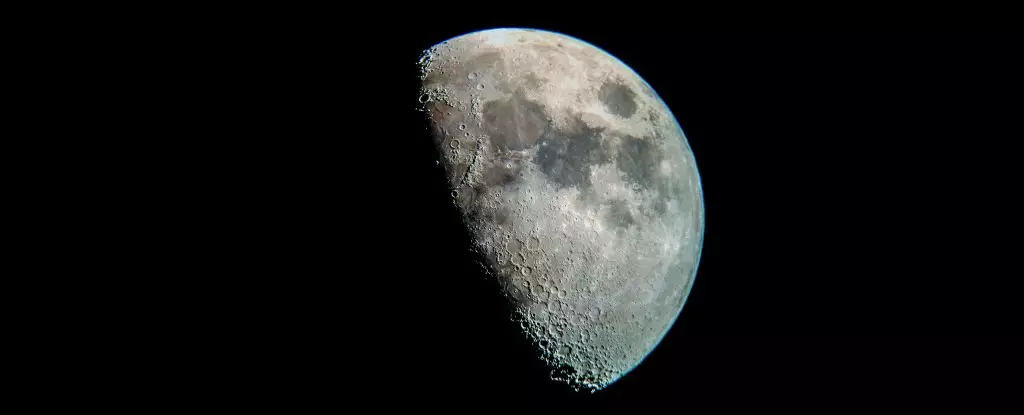The formation of the Moon, Earth’s only natural satellite, has long intrigued scientists, offering a window into the chaotic beginnings of our Solar System. Recent research by an international team comprising experts from the US, France, and Germany suggests that the Moon’s creation happened much sooner than traditionally thought, possibly just after Earth formed. This revelation holds the potential to shed light on various enigmatic aspects of the Moon, including its impact history and metallic composition.
Traditionally, scholars have posited that the Moon formed following a significant collision between the young Earth and a Mars-sized body. This cataclysmic event was believed to occur around 4.35 billion years ago, resulting in debris that eventually coalesced to create the Moon. However, new evidence carbon-dated suggests that the Moon may have been born as early as 4.53 billion years ago. This alters the timeline considerably, indicating that our Earth and its lunar companion have shared a long history together, perhaps from near the outset of Earth’s geological evolution.
The geologist Francis Nimmo and his team believe that the earlier formation date could explain some existing anomalies. For instance, the Moon displays a scarcity of large impact basins compared to the expected surface scars resulting from early planetary bombardments. Moreover, its surprisingly low metal content, particularly in comparison to Earth, might make more sense within this newly proposed framework of its formation.
To appreciate the implications of the new study, it’s vital to understand the early environment in which the Moon formed. The Solar System emerged roughly 4.6 billion years ago amid clouds of gas and dust surrounding the newborn Sun. In this tumultuous setting, numerous celestial bodies crashed into one another, forming larger planets. The prevailing theory suggested that a massive object impacted the Earth during its formative years, spewing a substantial amount of material into orbit. This material then accreted to form the Moon.
However, one of the intriguing pieces of evidence against this timeframe comes from lunar zircon crystals. These microscopic structures serve as a time capsule, capturing information about their formation process. The uranium-to-lead ratios within these zircons suggest ages of 4.46 to 4.51 billion years, significantly predating the previously assumed lunar formation timeline. This challenges the notion of the Moon having hosted a global magma ocean immediately after its creation.
In response to these conflicting geological records, Nimmo and his colleagues employed advanced modeling techniques to create a coherent narrative. They proposed that while the Moon did in fact form earlier than previously thought, a significant remelting event occurred around 4.35 billion years ago. This re-heating could explain the presence of ancient zircon crystals while simultaneously accounting for the more modern surface rocks that date to the same time period.
This hypothesis hinges on the concept of orbital eccentricity; during its formative years, the Moon’s orbit around Earth may have been elliptical rather than circular. As the Moon and Earth interacted gravitationally, tidal forces generated frictional heating that could have resulted in temporary melting of the Moon’s surface. If this interaction indeed occurred, it could account for the apparent discrepancy between the older zircon formations and the younger rock samples.
The consequences of these findings extend beyond just understanding the Moon’s formation. The early relationship between Earth and the Moon may have borne significant implications for their respective geologies. One such implication is the reduction of expected impact basins on the Moon’s surface. If tidal remelting did occur, it could obliterate many signs left by earlier impacts with celestial objects, aligning more closely with current observations.
Additionally, the scarcity of metallic elements on the Moon compared to Earth can be reevaluated through this new lens. If the Moon formed with material that included metals from colliding planetesimals and underwent remelting, those metals might have sunken into the deeper layers of the lunar crust, thus explaining their relative absence on the surface.
As new techniques and analyses emerge, our understanding of the Moon’s history continues to evolve. The recontextualization of its formation timeline may not only resolve multiple longstanding mysteries about our celestial companion but can also enrich our comprehension of Earth’s evolution. The interplay between the two bodies, grounded in shared history, remains a captivating subject for future research. As we delve deeper into the lunar past, we move closer to unearthing the secrets that bind the Earth and the Moon together in their eternal dance through the cosmos.


Leave a Reply